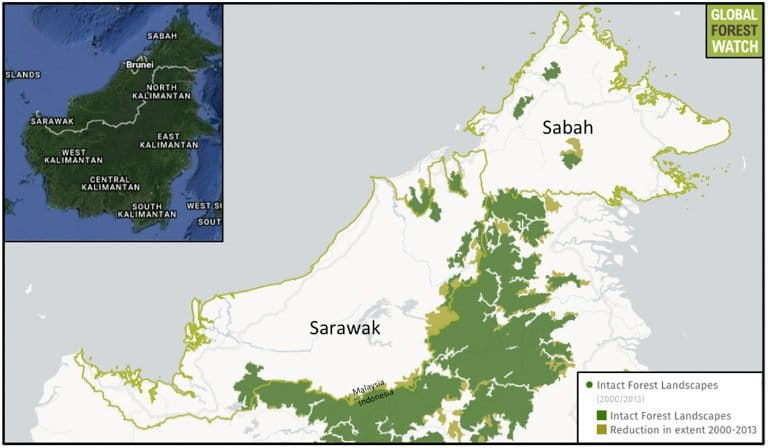- The study examined ‘initial intrusions’ into tropical forests and their effect on the threat status of species.
- The researchers found that deforestation at current rates in high-priority areas such as Borneo, the Congo Basin, and the Amazon could push 121 to 219 species closer to extinction in the next 30 years.
- While the authors point out that their conclusions are not a call to protect only intact landscapes, the data could help policymakers working with limited resources to decide where to place new protected areas.
The first bursts of deforestation in tropical areas can push a lot of species – more so than previously though – closer to extinction due to the loss of habitat, as well as activities that often follow such as hunting, farming, and mining.
That’s the conclusion of a study led by Matthew Betts, a landscape ecologist at Oregon State University. Betts and his team looked at how rates of forest loss impact the threat status of amphibians, birds, and mammals, and their conclusions point to the importance of safeguarding “intact landscapes.”
“Our results show that some of the first places we should be trying to slow those rates are in landscapes that are quite contiguous,” Betts said in an interview. The team published their research in the July 27 issue of the journal Nature.

The findings run counter to what many biologists have figured about the way deforestation rates impact species.
“A lot of the theory would indicate that, really, we should be most concerned about habitat loss when the total amount of forest or habitat drops below some critical threshold,” he said, often indicated as a percentage of forest loss. “Generally, it’s thought that that threshold is pretty low.”
In other words, the focus is often on protecting areas that already bear the signs of human use. The thought is that many species can survive mild losses of habitat, so long as their homes don’t disappear altogether.
But when Betts and his colleagues looked at how the species’ threat statuses had changed since 2000, they found that the “initial intrusion” into places with 90 percent or more forest cover was more destructive than anticipated. In those areas, the chance that a species would become more threatened as a result of the loss was much higher than in areas with middling amounts of forest.
That discovery is evidence that the first pulses of destruction force many species through what scientists call an “extinction filter,” Betts said.
“In hindsight, it makes sense,” he added, “in that the first species we lose are the ones that are the most specialized and the most sensitive to development.”

The team leveraged the data from satellite imagery on tree cover loss and gain compiled by ecologist Matt Hansen’s team at the University of Maryland, focusing on intact forest landscapes. IFLs, for short, are “unbroken” areas of forest at least 500 square kilometers (193 square miles) in size that are visibly devoid of signs of human use.
To track wildlife populations, Betts and his colleagues looked at the ranges of nearly 19,500 animals, about 23 percent of which are listed as threatened, using IUCN’s Red List and databases compiled by Birdlife International and NatureServe.
The analysis revealed several hotspots – notably the central Amazon, the Congo Basin and the island of Borneo – as places where 121 to 219 species could become threatened in the next 30 years if we continue to lose forests at current rates.
For Malaysian Borneo in particular, satellite data from the University of Maryland show few IFLs were left as of 2000. And many of those that do remain were heavily degraded between 2000 and 2013.
Betts said his presentation of the research on Monday at the International Congress for Conservation Biology in Cartagena, Colombia, “raised eyebrows” – which isn’t too far from his own initial reaction to the findings.
“It was a little surprising to me to see that rapid rates of forest loss at the high end of forest amount were far more important,” he said.

Still, Betts cautioned against drawing simple conclusions from these results.
“It should not be, ‘Let’s just maintain intact forest landscapes and let the rest go to hell,’” he said.
Wiping out all of the habitat in degraded areas would also predictably send species tumbling toward extinction, Betts said.
This research could, however, provide additional information that might help conservationists and policymakers with the tough decisions they face about where to protect forested habitats.
It also shows that opportunities exist for protection that could result in saving more species. The researchers report that less than 18 percent of the high-priority areas they identified in South America, Africa, and Asia are protected at all, and only about 9 percent qualify as having “strict protection” under IUCN guidelines.
“The ideal would just be to do that across the world, everywhere,” Betts said. “But given limited resources and the need for forest products, we need to think about where we should be trying to slow those rates of forest loss.”
CITATIONS
- Betts, M. G., Wolf, C., Ripple, W. J., Phalan, B., Millers, K. A., Duarte, A., … & Levi, T. (2017). Global forest loss disproportionately erodes biodiversity in intact landscapes. Nature.
- Greenpeace, University of Maryland, World Resources Institute and Transparent World. “Intact Forest Landscapes. 2000/2013” Accessed through Global Forest Watch on 27 July 2017. www.globalforestwatch.org
Banner image of Monkey frog (Phyllomedusa bicolor) in Peru by Rhett A. Butler.
FEEDBACK: Use this form to send a message to the author of this post. If you want to post a public comment, you can do that at the bottom of the page.














